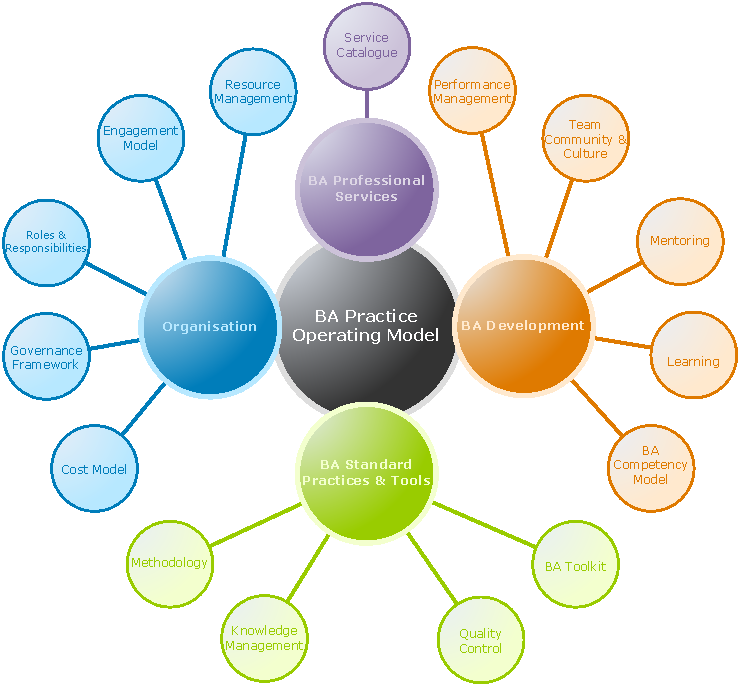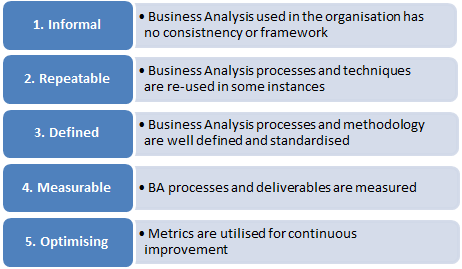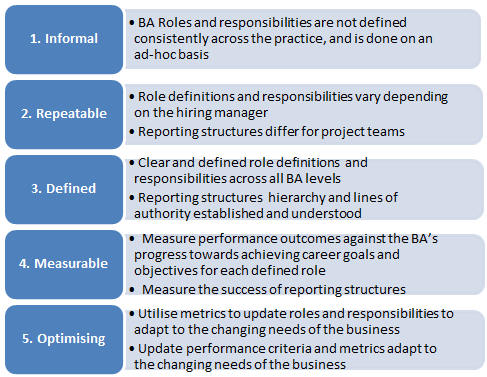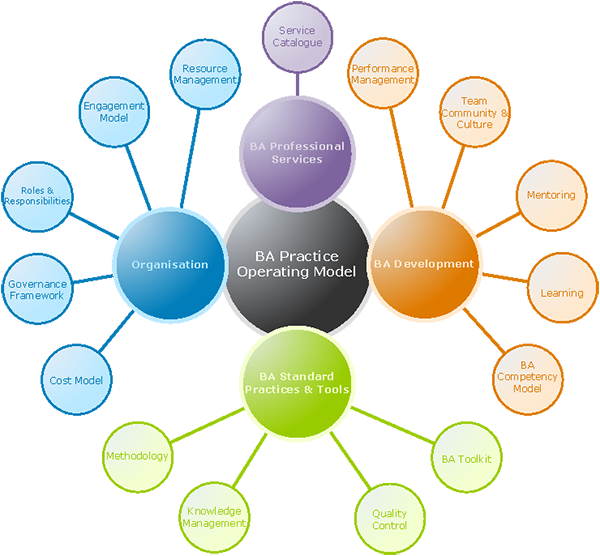Maturing a Business Analysis Practice Operating Model
Operating Model for Business Analysis Practices
The growing importance of Business Analysis in projects and organizations has led to the need for a standardized operating model for…
Business Analysis Practices to have a simplified and common view of Business Analysis governance, processes, engagement, services, and development. All these areas must work together in unison to provide effective and efficient business analysis and enable successful project delivery.
Related Article: Defining a Business Analysis Operating Model
This is the second article of a two-part series; the first is to introduce the Business Analysis Operating Model which defines what an operating model is, and how you run your BA practice to align with your vision. This article describes the development of a Maturity Model used to measure the areas that make up the Business Analysis Operating Model.
Maturity Model for Business Analysis Operating Model
The purpose of a maturity model is to understand the current and future maturity of the practice and measure the progress the BA Practice has made in reaching its objectives at a point in time. It allows the BA Practice to:
- have its methods and processes assessed against a clear set of criteria for each area of the BA Operating Model (refer to Diagram 1 below)
- have a benchmark to measure the performance of its operating processes internally and externally
- use a framework to develop a strategy for envisioning the future, desired state and the development of improvement plans
- ultimately deliver better outcomes and benefits for the organization
 Diagram 1: BA Operating Model
Diagram 1: BA Operating Model
The Five Levels of Maturity
The Maturity Model is defined as five levels ranging from Informal to Optimising. A lower level of maturity indicates a lower probability of success in consistently meeting BA Practice objectives and project outcomes. A higher level of maturity indicates a higher probability of success. Provided that the criteria do not change for levels 1 to 3, work to uplift the maturity in a particular area will always loop on levels 4 and 5 as we continually define the metrics on an area and utilize it to implement maturity uplift initiatives.
The table below describes each of the levels and how it relates to the BA Practice overall:
 Table 1: Five Levels of Maturity – BA Practice
Table 1: Five Levels of Maturity – BA Practice
Development of Business Analysis Maturity Model
 Diagram 2: High-Level Process in BA Maturity Model Development
Diagram 2: High-Level Process in BA Maturity Model Development
For BA Practices to measure its maturity consistently, a set of standardized criteria must be established. Each area of the BA Operating Model has criteria defined at each level of maturity. This will allow you to assess the level of maturity the BA Practice is at for each area of the BA Operating Model. Once the current maturity assessment is done for all areas of the Operating model, work can be prioritized to focus and uplift the maturity based on the BA Practices and organizational objectives.
Criteria Definition
Criteria are to be defined for each level of maturity for each area of the BA Operating Model in order to evaluate whether the BA Practice is achieving the desired outcome. The criteria determine the conditions that need to be satisfied to reach the particular maturity level.
As part of this process, it is important to not only engage the staff involved in the area of the BA Operating model but also the wider the BA community in the Practice in order to gain consensus and encourages involvement in subsequent activities to improve the maturity. The table below is an example of the criteria defined for the “BA Roles and Responsibilities” area of the BA Operating Model:

Table 2: Five Levels of Maturity – BA Roles and Responsibilities
Maturity Assessment
Once the criteria have been defined, an assessment exercise can begin to determine which maturity level the BA Practice is at for each area. As with the criteria definition, the assessment should involve BAs who is working closely in the area but also the wider BA Community to support a more realistic assessment, gain consensus from the BA community and ultimately empower the BAs to improve the maturity.
Diagram 2: Current Maturity Assessment of BA Operating Model
Maturity Uplift
The Maturity Model allows the prioritization of which, where and how the critical work gets done across the BA Practice. It serves as the vital link between the Practice’s strategy and the execution plan that it puts in place to deliver on the strategy (refer to diagram 3 below). The BA Maturity Model, in turn, provides a reference on the progress made at a point in time, in relation to the objectives desired. For example:
- One of the strategies is to leverage BA resources and maximize resource management capability
- That strategy maps to the “Resource Management” area in the BA Operating Model which has a maturity model level 2
- That defines the execution plan which is to develop a framework and leveraging existing resources across the enterprise

Diagram 3: Operating Model linking strategy and execution
Tailoring an Operating Model and Maturity Model towards the strategy of the BA Practice provides a consistent and standardized approach to improving the governance and management of a BA Practice as well as delivering high-quality BA services and deliverables. Regular re-assessment on both models is also equally important in order to adapt to organizational and strategy change, and industry trends.
About the authors:
 Momoko McCartney is a Lead Business Analyst at a major financial institution in Melbourne, Australia. She is a project professional with over 14 years with expertise in the business analysis and delivery of complex IT and performance improvement projects across a range of different industry sectors, including Finance, Energy, Health, Resources & Mining and Higher Education.
Momoko McCartney is a Lead Business Analyst at a major financial institution in Melbourne, Australia. She is a project professional with over 14 years with expertise in the business analysis and delivery of complex IT and performance improvement projects across a range of different industry sectors, including Finance, Energy, Health, Resources & Mining and Higher Education.
 Edward Hun is an accomplished Senior Business Analyst at a major financial institution in Australia. He has a 10-year record of delivering BA services and deliverables within at all phases of the lifecycle in the finance and banking industries. His commitment to getting project objectives and requirements right at the start of a project has consistently paid dividends. This commitment has given him a strong passion for learning and advocating Business Analysis best practices and techniques.
Edward Hun is an accomplished Senior Business Analyst at a major financial institution in Australia. He has a 10-year record of delivering BA services and deliverables within at all phases of the lifecycle in the finance and banking industries. His commitment to getting project objectives and requirements right at the start of a project has consistently paid dividends. This commitment has given him a strong passion for learning and advocating Business Analysis best practices and techniques.
If you have any feedback or need any tips and advice on BA Operating and Maturity Models, please feel free to contact us.
References
1. Capability Maturity Model (CMM) – Wikipedia
The CMM model was used as a basis to define the 5 levels of maturity for the BA Operating Model.
2. Kathleen Hass – Business Analysis Practice Maturity Model
Kathleen Hass has also defined a Maturity Model for BA Practices, with a focus on value-added services provided by BAs. Whilst we have not used any techniques from her model, it is another good model you can have a look at to uplift the maturity of your BA Practice.


 Diagram 1 – BA Operating Model
Diagram 1 – BA Operating Model